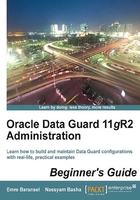
Time for action – verifying the standby database configuration
Run the following actions to verify the standby database configuration and redo transport services:
- Connect the standby database using SQL*Plus and check for the database role and status to ensure the database role is the physical standby.
SQL> select db_unique_name,database_role,open_mode from v$database; DB_UNIQUE_NAME DATABASE_ROLE OPEN_MODE --------------- ---------------- -------------------- india_un PHYSICAL STANDBY MOUNTED
- Check the standby database,
SPFILE.SQL> show parameter spfile NAME TYPE VALUE ------ ------- -------------------------------------------------- spfile string /u01/app/oracle/product/11.2.0/db_1/dbs/spfileINDIA.ora
Tip
If you have started the standby instance with
PFILE, you should create anSPFILEand start an instance again using the newSPFILE. - Use the
v$datafileview to check the location of the datafiles in the standby database. The standby database datafile must be under the/u02directory because of theDB_FILE_NAME_CONVERTparameter setting.SQL> select name from v$datafile; NAME --------------------------------------------- /u02/app/oracle/oradata/orcl/system01.dbf /u02/app/oracle/oradata/orcl/sysaux01.dbf /u02/app/oracle/oradata/orcl/undotbs01.dbf /u02/app/oracle/oradata/orcl/users01.dbf /u02/app/oracle/oradata/orcl/example01.dbf
- Use the
v$logfileview to check the location of online and standby redo logfiles in the standby database.SQL> select group#,type,member from v$logfile; GROUP# TYPE MEMBER ---------- ------- ---------------------------------------------- 3 ONLINE /u02/app/oracle/oradata/orcl/redo03.log 2 ONLINE /u02/app/oracle/oradata/orcl/redo02.log 1 ONLINE /u02/app/oracle/oradata/orcl/redo01.log 4 ONLINE /u02/app/oracle/oradata/orcl/redo04.log 10 STANDBY /u02/app/oracle/oradata/orcl/standby_redo01.log 11 STANDBY /u02/app/oracle/oradata/orcl/standby_redo02.log 12 STANDBY /u02/app/oracle/oradata/orcl/standby_redo03.log 13 STANDBY /u02/app/oracle/oradata/orcl/standby_redo04.log 14 STANDBY /u02/app/oracle/oradata/orcl/standby_redo05.log
Note that the online redo logfiles and standby redo logfiles in the primary database are created under the
/u01directory, whereas logfiles in the standby database are under/u02. This change occurred because of the settings of theLOG_FILE_NAME_CONVERTparameter.SQL> show parameter log_file_name_convert NAME TYPE VALUE ---------------------- ----------- ---------------------------- log_file_name_convert string /u01/app/oracle/oradata/orcl, /u02/app/oracle/oradata/orcl
- Verify if the redo transport service is active using the
v$managed_standbyview on the standby database:SQL> SELECT THREAD#,SEQUENCE#,PROCESS,CLIENT_PROCESS,STATUS,BLOCKS FROM V$MANAGED_STANDBY; THREAD# SEQUENCE# PROCESS CLIENT_P STATUS BLOCKS ---------- ---------- --------- -------- ------------ ---------- 1 148 ARCH ARCH CLOSING 6 1 147 ARCH ARCH CLOSING 8 1 149 RFS LGWR IDLE 1 0 0 RFS UNKNOWN IDLE 0
You must see RFS processes running on the standby database, which are responsible for writing redo information that the primary database sends to standby.
What just happened?
We've verified the standby database mode, status, and database files. We've also seen that the redo transport service is actively working between primary and standby.
Managing Redo Apply
As discussed in Chapter 1, Getting Started, Redo Apply is the synchronization method of the physical standby databases. Now let's see how can we start, stop, and monitor Redo Apply.